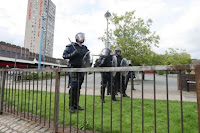Last week was hectic! The first day back from work came and went at an almost bewildering speed.
The oasis of calm on Monday was a PhD viva – the second time for the student and this time such a better experience for all. There is something very special in spending that couple of hours having a conversation with someone passionate enough about a particular question that they spend three, four or more years studying it. And for me, once that door has closed and the viva starts, the outside world cannot intrude – it is an almost self-indulgent activity. For this candidate it was a successful conclusion to five years work, allowing a welcome return to his family and friends.
My new office, started on Saturday, was welcoming but not complete – somehow it didn’t quite work for me. It was Tuesday before I began to feel a creative certainty over what to do – chairs were exchanged, pictures placed on walls and at a stroke the room delivered on its promised magic. What I had been missing for a while now was a space that would allow me to think, write and converse with others. By the time I had got to Tuesday going home time, I felt I was getting somewhere, and the new office was starting to feel like a place to centre ones thoughts in. Just as well perhaps, as it took me two hours to get home that night.
The riots, sparked by a death of a young man in London had spread north. Starting in Salford, the dissent and mindless wanton destruction quickly spread to Manchester city centre. The result (coupled with an accident on the M60) was gridlock and the inevitable long journey home. All comparisons are odious, and I was particularly put out by the way in which the media kept cross referencing the behaviour of rioters in Manchester with the street protests there were in Thatcher’s early years. It was strange watching the old archive films of the anti Thatcher protests on the news programmes, and for me, a little sad.
Later on in the week I started the task of preparing for a two day workshop next week aimed at trying to consider what the future holds for mental health care providers and service users in the North West. My approach to such tasks is to search for, download and print off, everything I can find to read on the question being addressed. It is an activity akin to that sense one gets with the ethnographic immersion into the field that typifies the work of anthropologists. In this case it is a form of anthropology, sometimes called armchair anthropology that sees the ‘anthropologist’ using and relying upon the work of others to provide the ‘data’ for analysis. For me it is an approach that inspires huge amounts of creative analytical thought.
It was Edward Tylor who is considered to be the greatest armchair anthropologist. Tylor’s first and only field trip was to Mexico in 1856. He never traveled anywhere again to collect data, although he continued to study the customs and beliefs of many different tribal communities, both existing and prehistoric. His work, Researches into the Early History of Mankind and the Development of Civilization, published in 1865 was based entirely on the studies and information collected by others. His most influential work however was, Primitive Culture published in 1871. This work set the foundations for what we know today as cultural anthropology.
This week, I have trawled my way through over 45 separate pieces of policy, governmental guidance, white and green papers to try and gain a sense of where it is we have come from and where it might be we are going to in terms of new directions for mental health care. It is a process that involves first deconstructing the [policy] rhetoric in order to be able to re-construct a new view of a possible future.
In dealing with all the day to day turbulence of change that has characterised much of my work over the past six months, I had forgotten what a pleasure it is to sit in the seat of the armchair anthropologist once more. Now I have a new creative space, it is a seat I intend to occupy a lot more in the future.




No comments:
Post a Comment